Gravel garden at Chanticleer reminds me of Texas
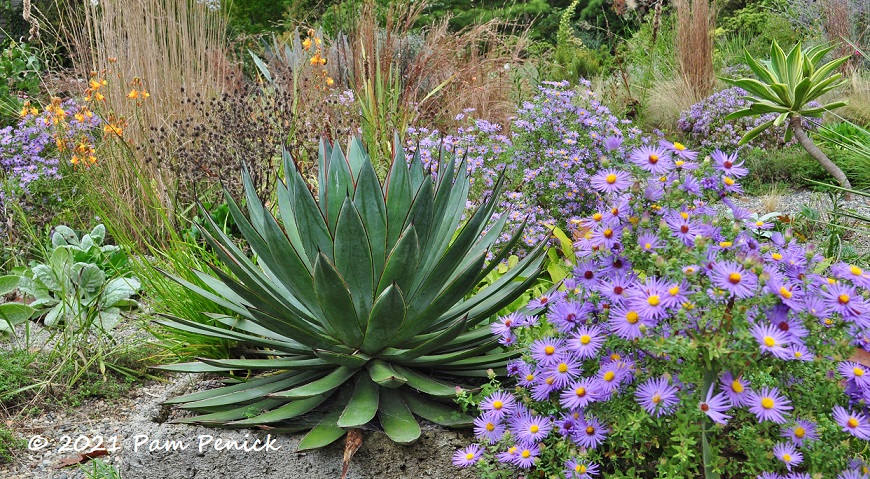
Whether you love plants, exciting planting combos, design and gardening artistry, or overlooks and hideaways to sit and enjoy a beautiful garden, Chanticleer has it all. Located near Philadelphia, Chanticleer dubs itself “a pleasure garden,” and it’s been my favorite public garden since I first visited in 2008. I returned in 2016 and was bowled over again; check out my 2016 blog posts for the Chanticleer backstory and lots of photos. Naturally I’d reserved tickets for another day-long visit during the Pennsylvania portion of my big road trip last October. And now I’ve cued up 6 new Chanticleer posts to share with you!
Let’s start with the garden that reminds me most of my Texas home — an idealized version, mind you: the Gravel Garden.
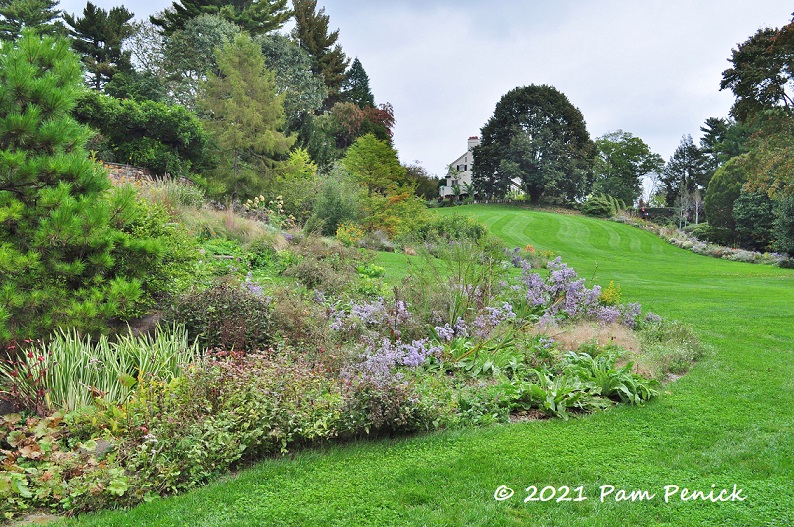
Well, OK — obviously this isn’t Texas but the fertile Brandywine Valley. The Gravel Garden sits upslope to the left, encircled on two sides by a broad, curving lawn that acts as a view corridor from the house on the hill down to a pond garden.
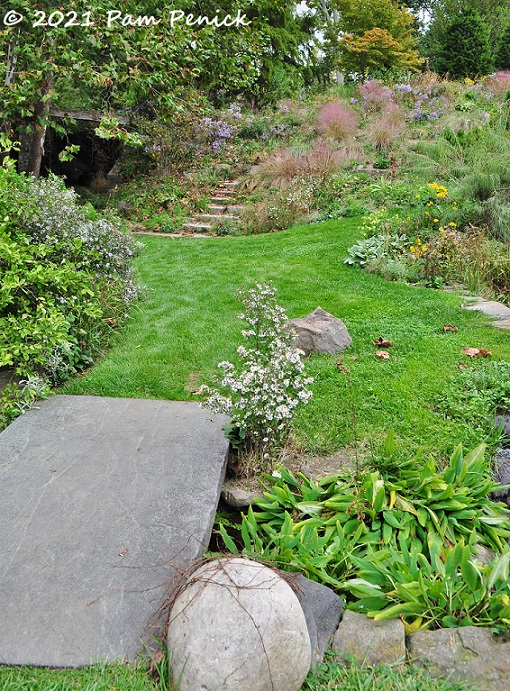
Let’s cross the stone bridge and head up the hill, where fluffy, pink-flowering Gulf muhly beckons.
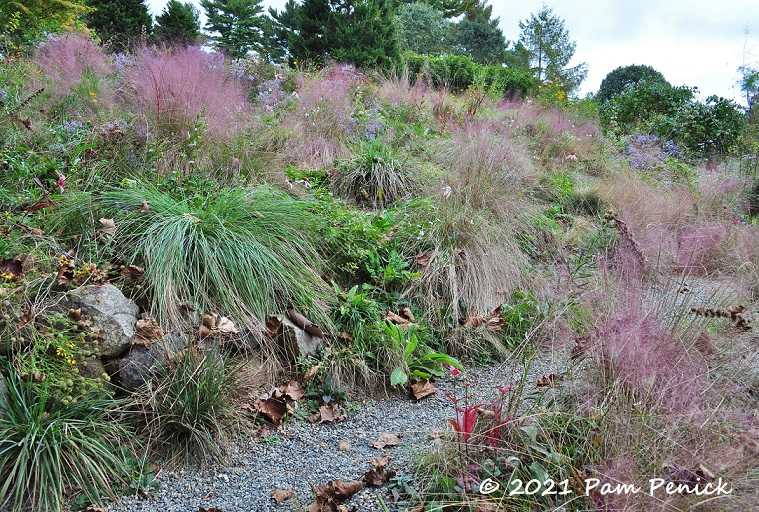
Now this could be Texas, if you ignore the tall conifers in the background.
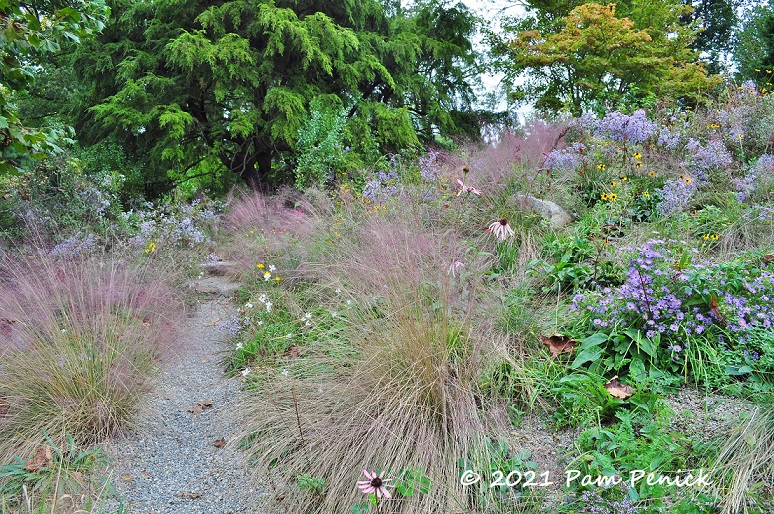
Gulf muhly grass and asters and even purple coneflower — a glorious fall combo
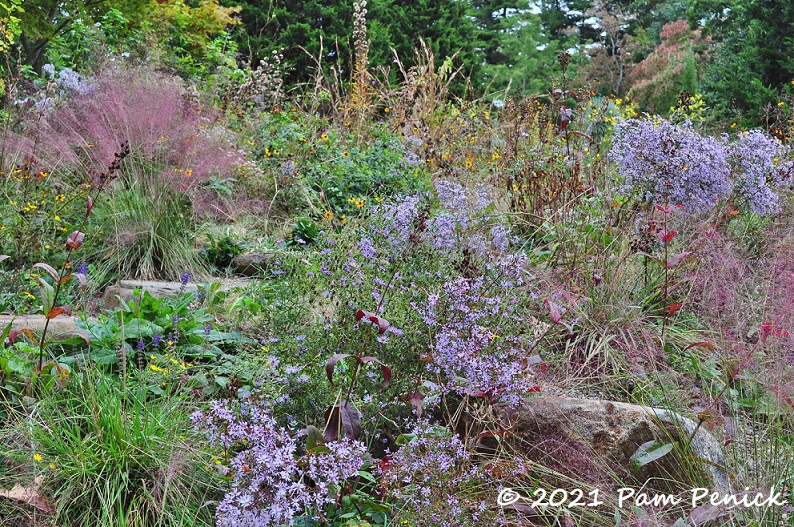
The upslope view
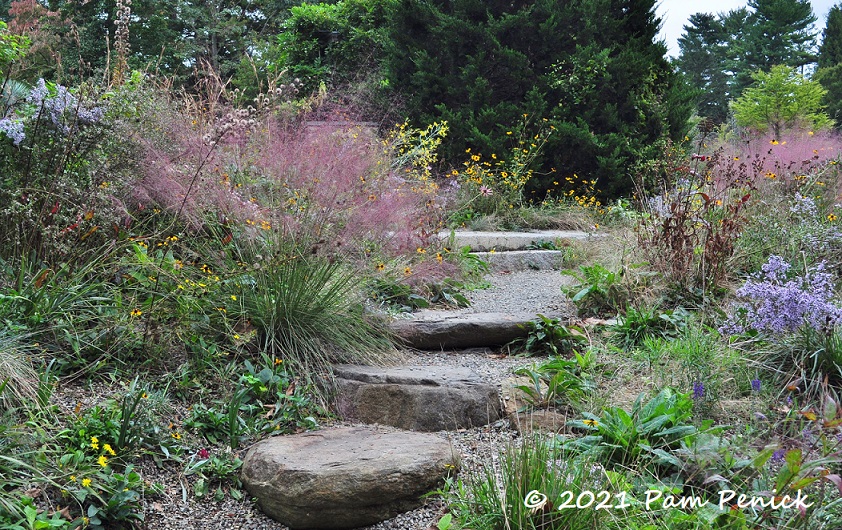
A switchback stone-and-gravel path offers many opportunities to enjoy the view above…
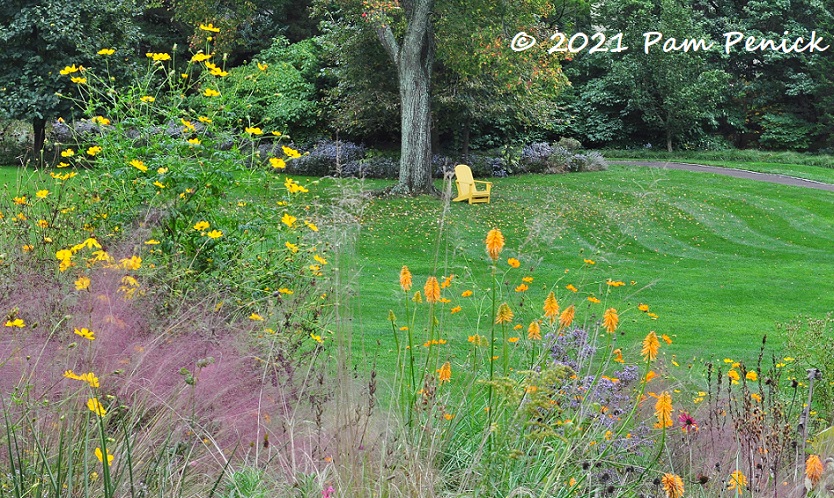
…and below.
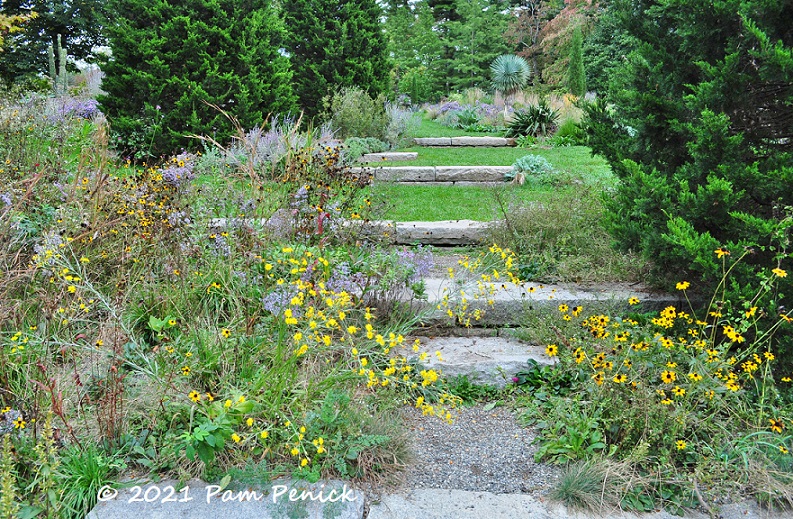
Near the top, stone terracing zigzags across a small lawn. Ahead a shimmering Yucca rostrata — yes, in Pennsylvania — beckons.
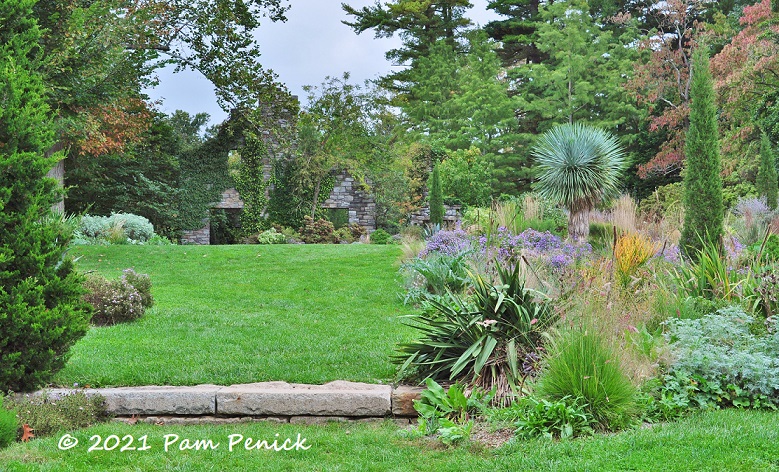
An ivy-cloaked ruin — a fabricated ruin, so more of a folly? — appears at the lawn’s end, framed by the garden.
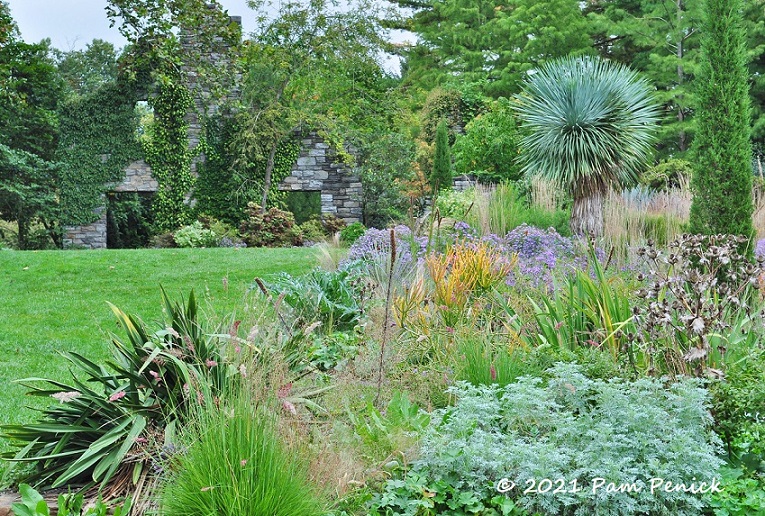
I see plants familiar to Central Texas gardeners: ruby grass, ‘Powis Castle’ artemisia, eryngium, aster, yucca.
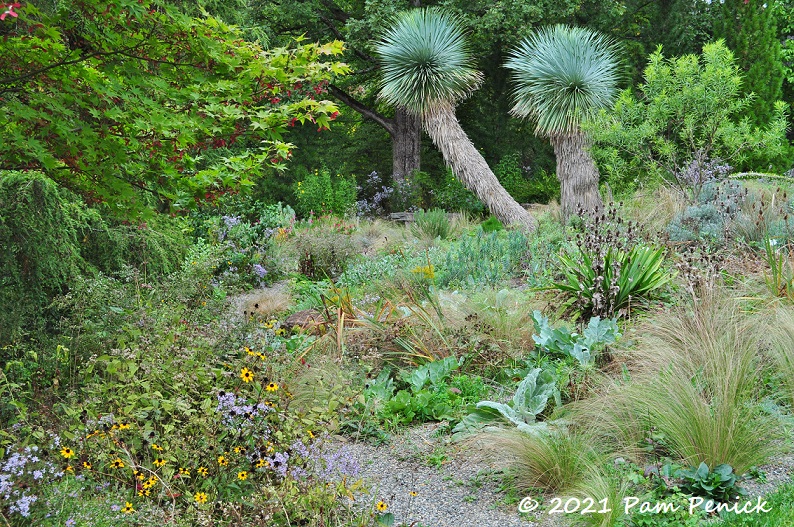
Looking left across the lawn, another bobble-headed cluster of Yucca rostrata makes a surprising focal point. A mix of silvery green and tawny gold plants echoes the color of Austin gardens in the fall.
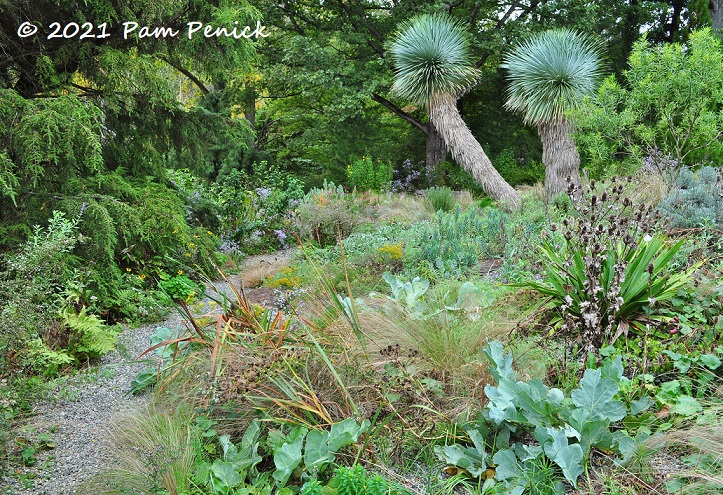
Let’s explore a side path.
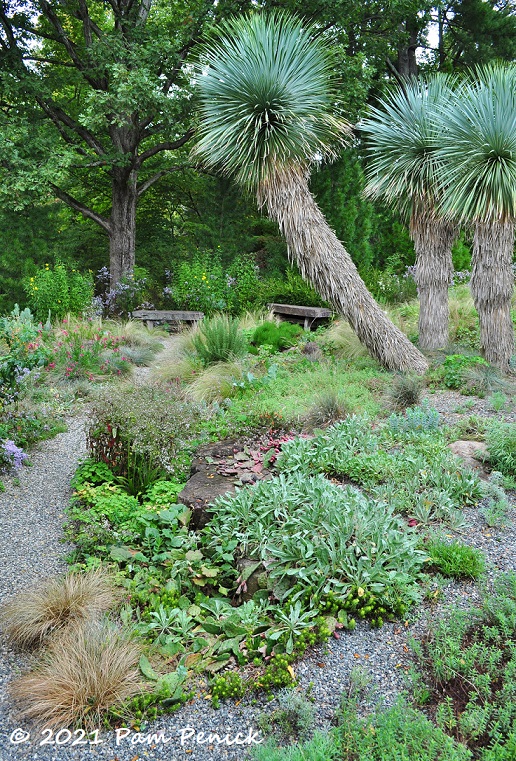
It leads to a semi-secret pair of benches tucked against a green backdrop.
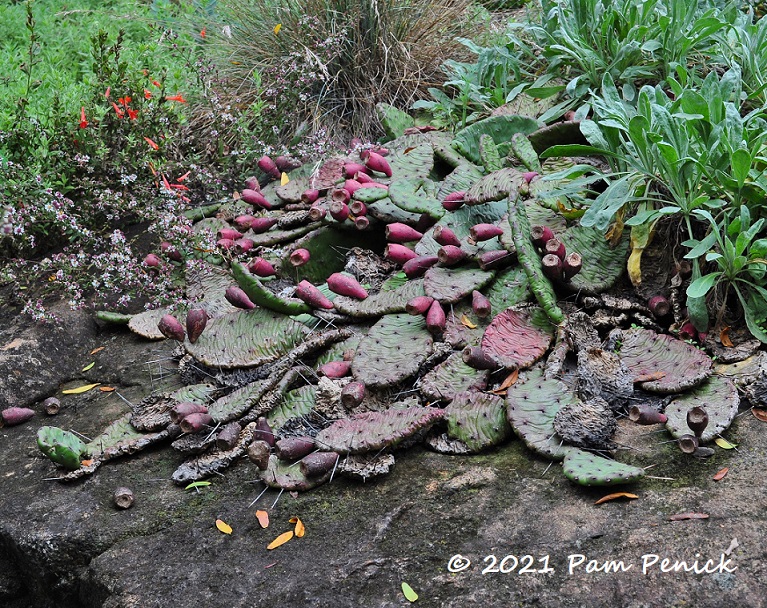
An exhausted prickly pear, still adorned with raspberry-colored tunas (fruit), lies in flattened heap on a large rock. Is this normal fall behavior for prickly pear in Pennsylvania?
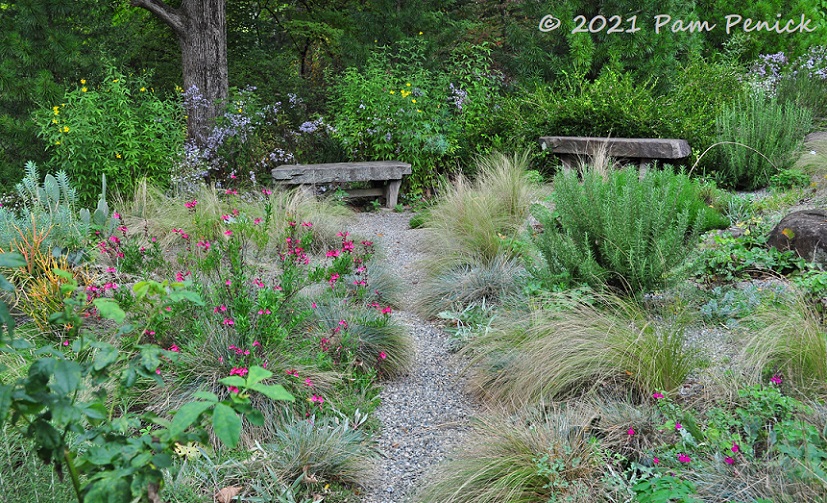
Hot-pink Salvia greggii, arching clumps of Mexican feathergrass, and rosemary bring on the Texas vibes.
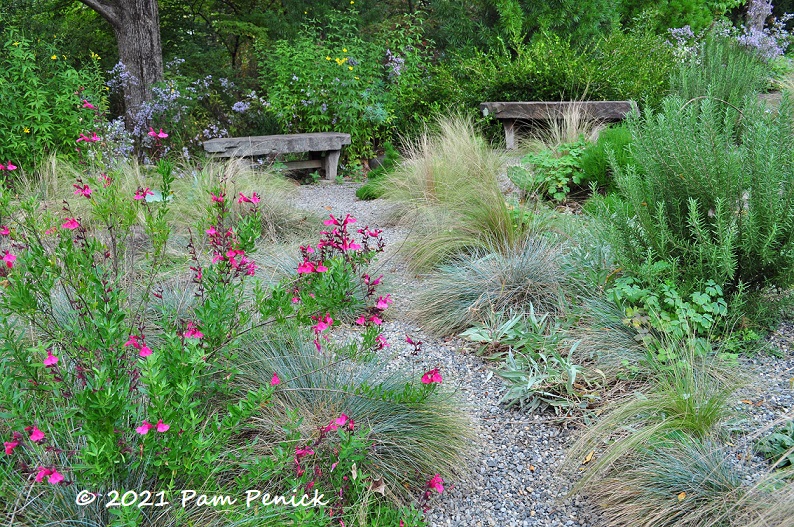
I covet the addition of blue fescue, which I rarely see in Austin.
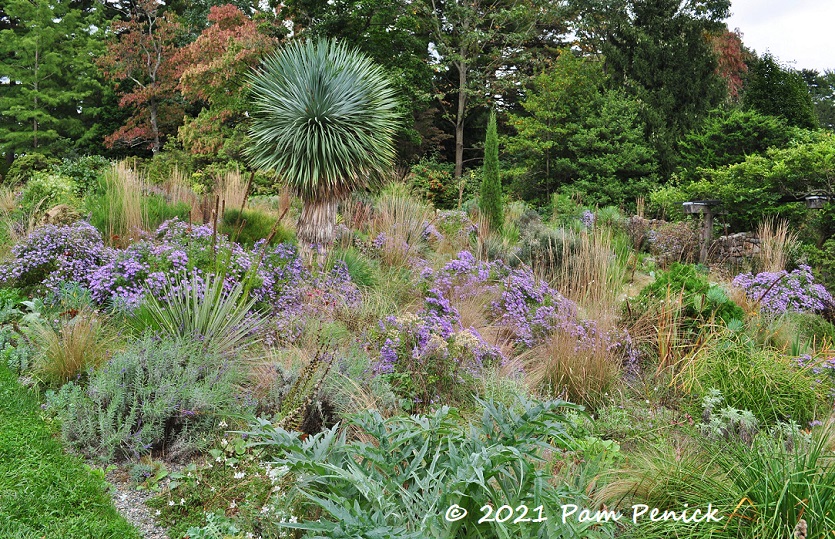
Heading back over to the larger dry garden, I love this scene with asters running like a purple stream through tawny grasses and the silvery blues of yucca and cardoon.
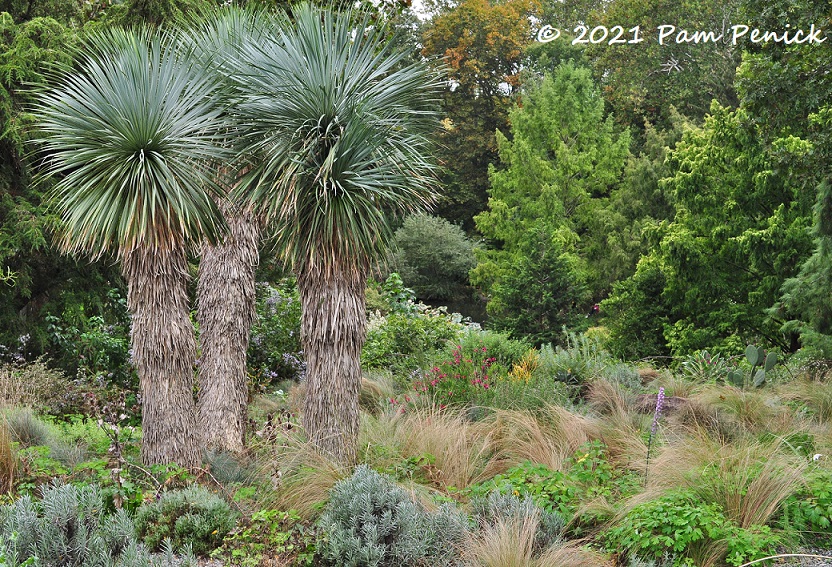
Statuesque Yucca rostrata
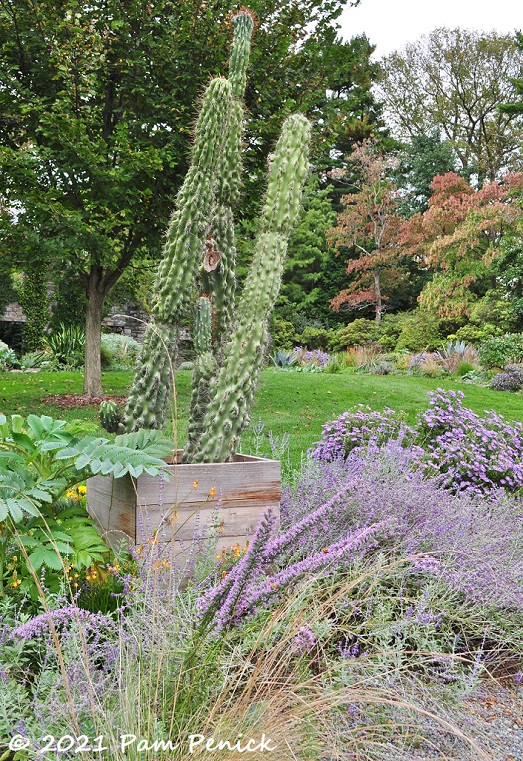
Another striking vertical accent: a boxed cactus
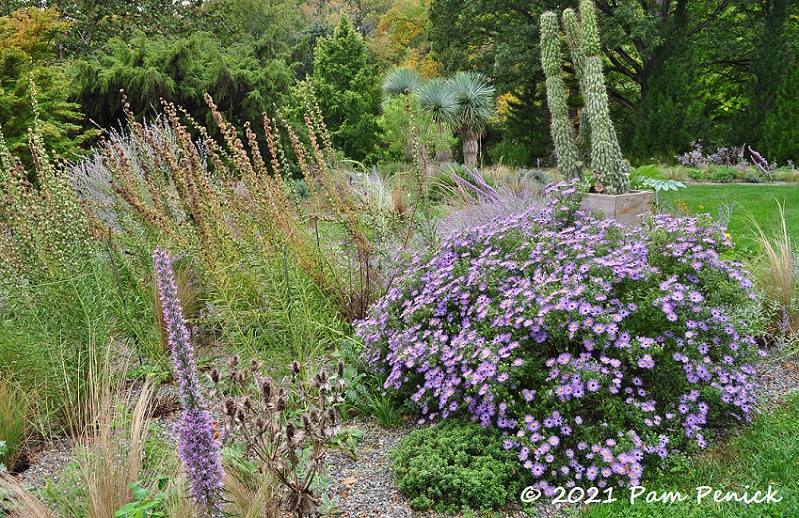
Cactus-echoing vertical flower spikes
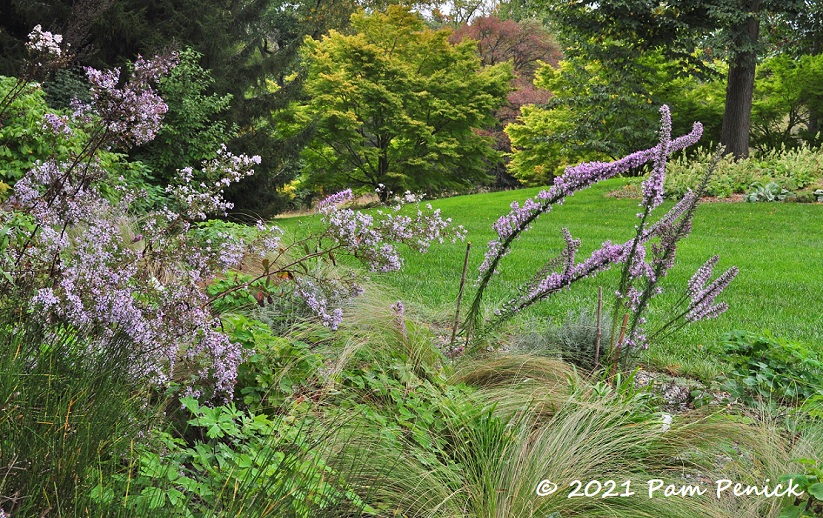
More lovely purples, with trees starting to turn in the background.
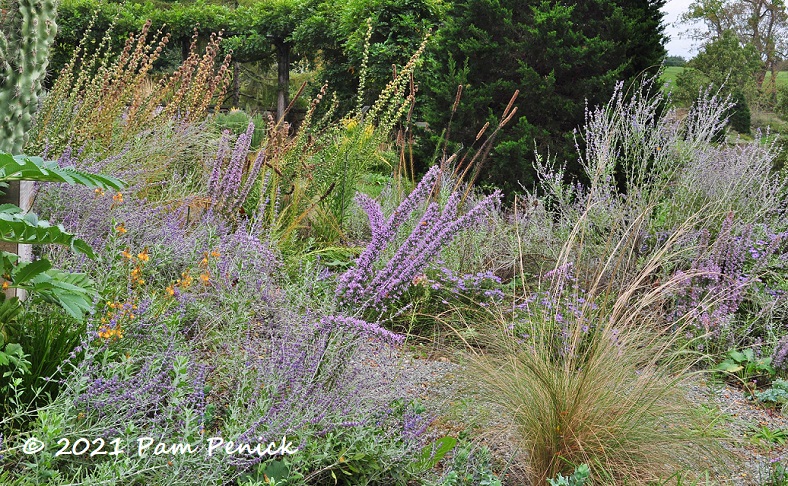
Beautiful texture and color
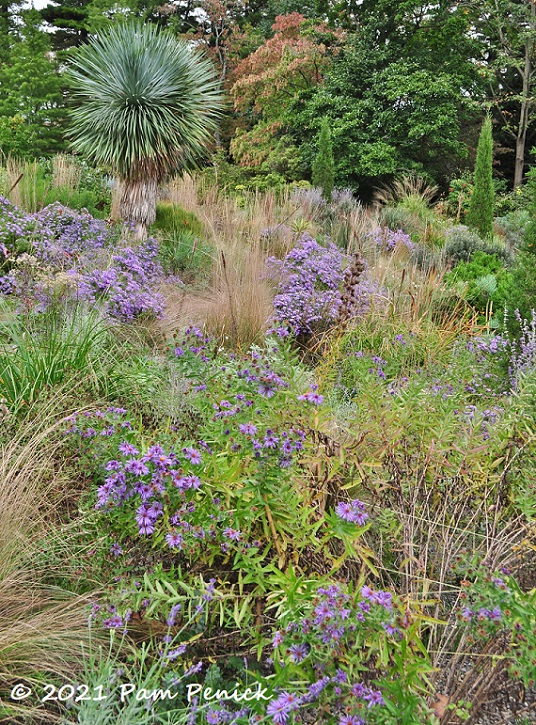
It’s a mini-meadow, a pocket prairie.
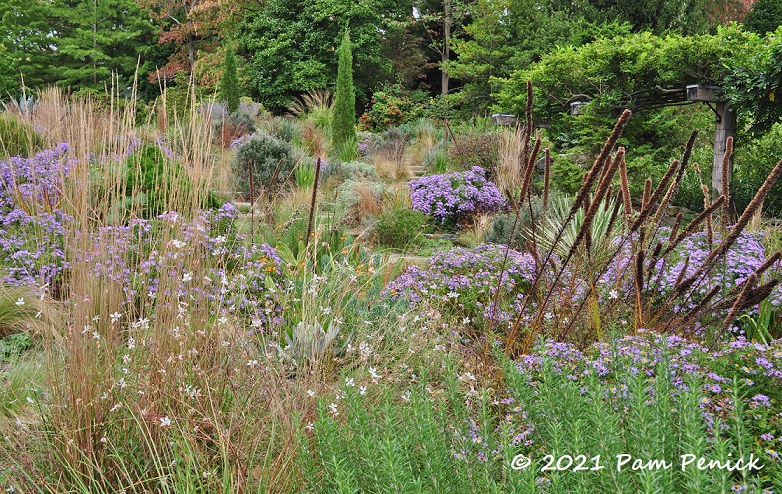
Skinny columnar trees at the back add verticality, as does a vine-covered pergola, a scrim of ‘Karl Foerster’ grass, and liatris flower spikes gone to seed.
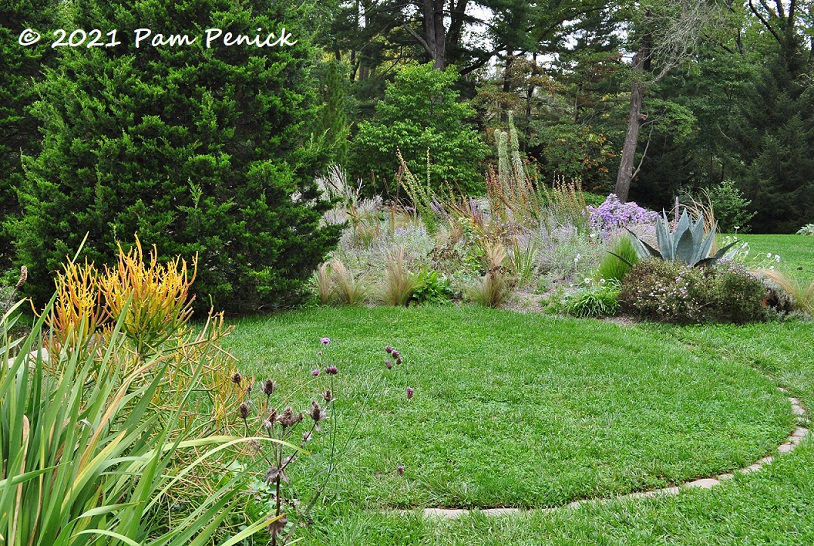
A stone circle inset into the lawn makes a unique landing as you come up the terraced steps (at left) and look ahead to the ruin.
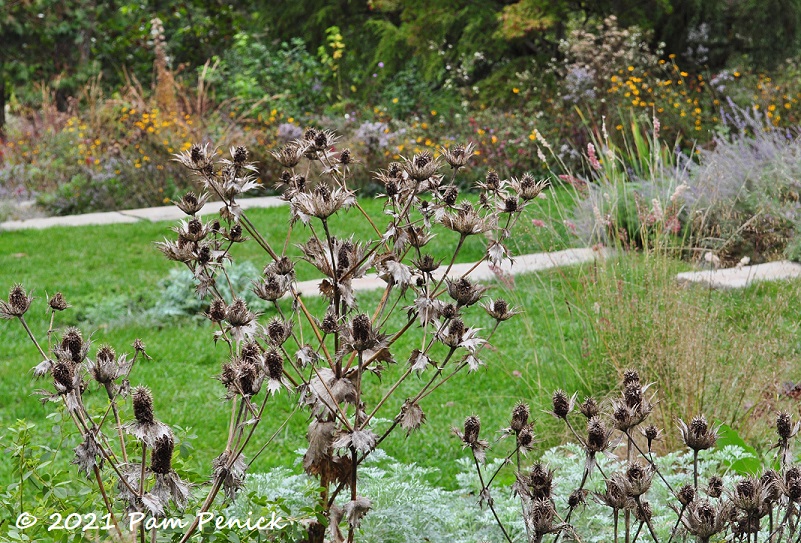
Eryngium gone to seed
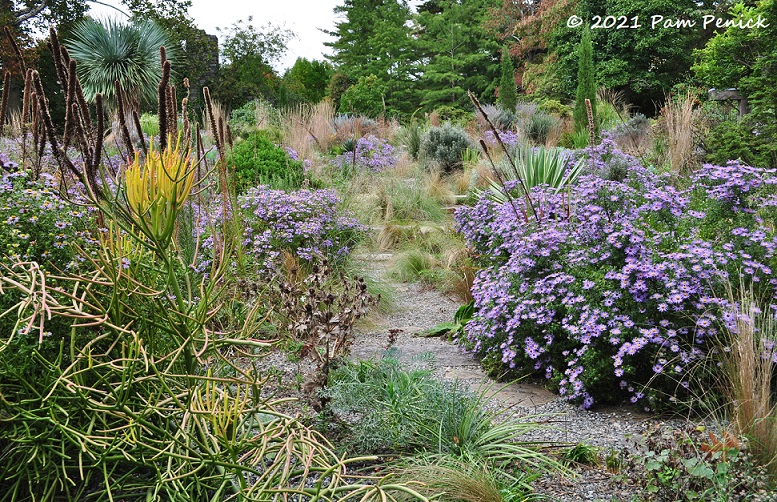
A narrow path winds through this bed, past masses of ‘October Skies’ asters and the occasional surprise of sticks-on-fire euphorbia.
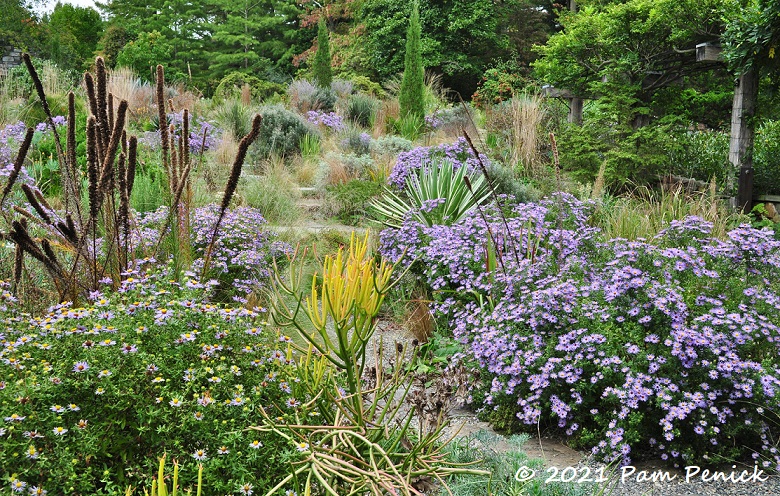
More liatris wands and asters
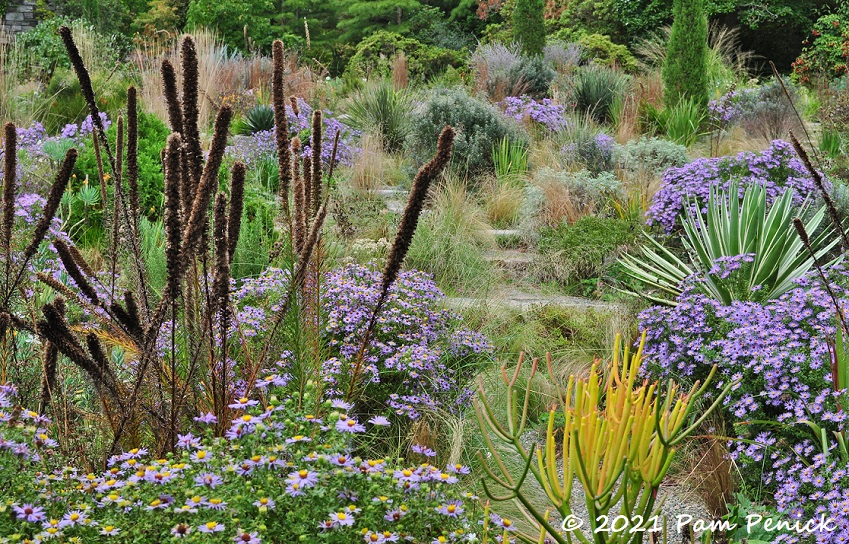
Even after its flowers have faded, liatris adds structure and, yes, color — a toasty, chocolate brown.
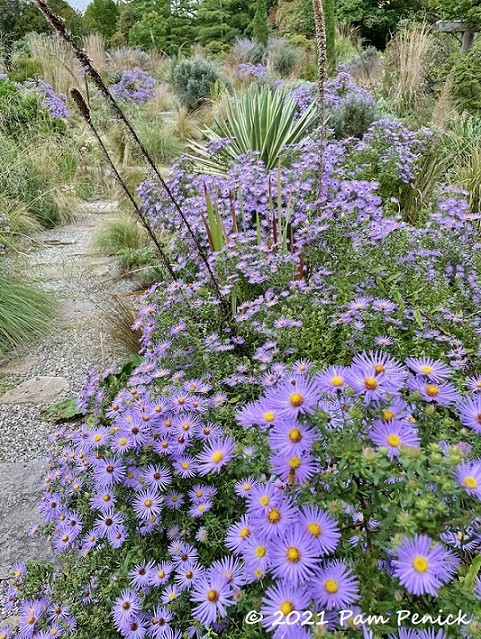
Loads of ‘October Skies’ asters
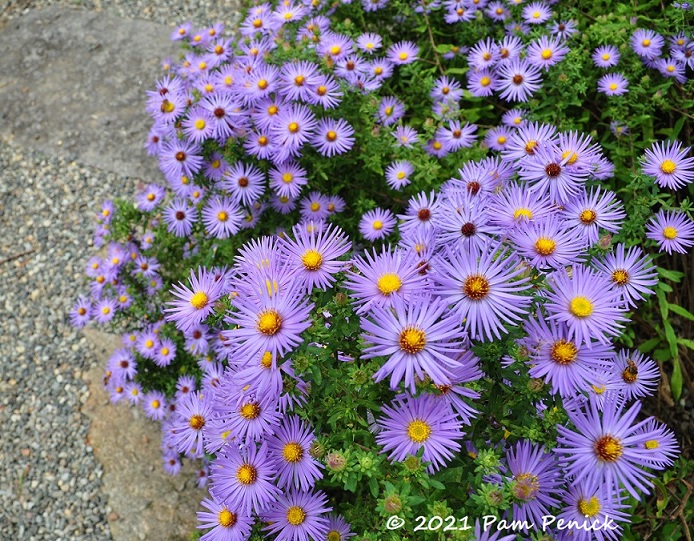
More!
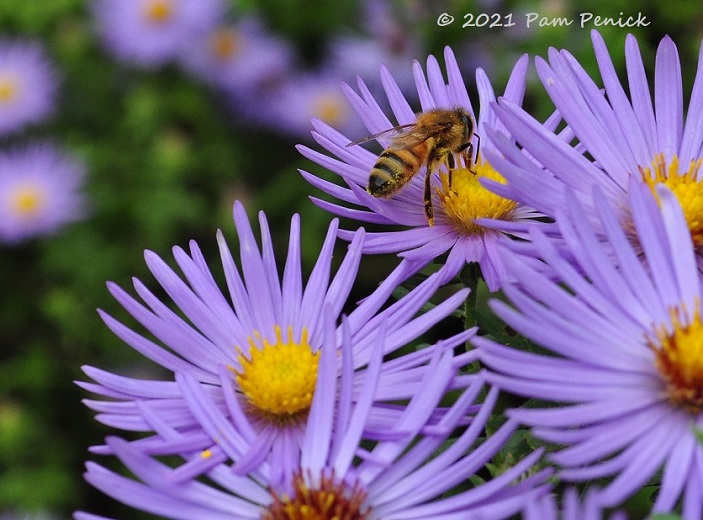
Bees love it too.
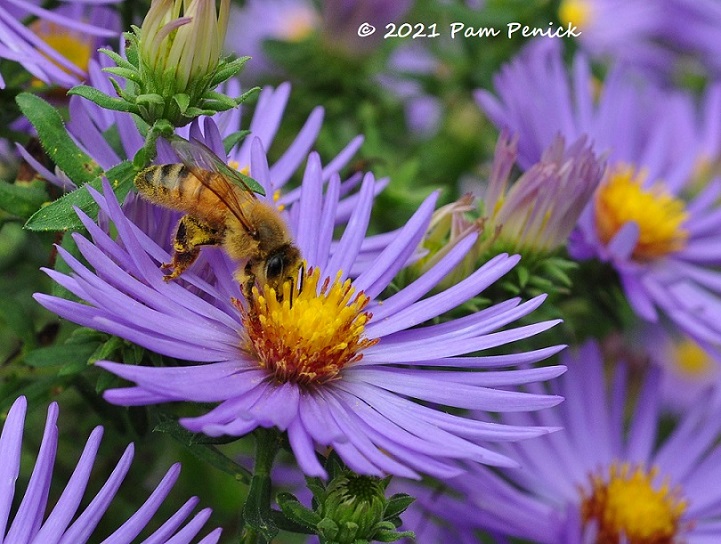
Getting after it
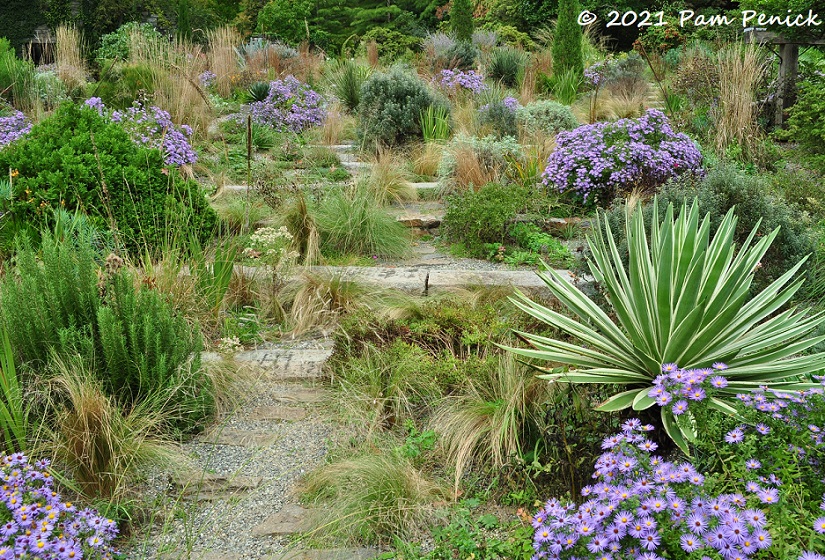
A variegated yucca — or agave? — adds spherical form.
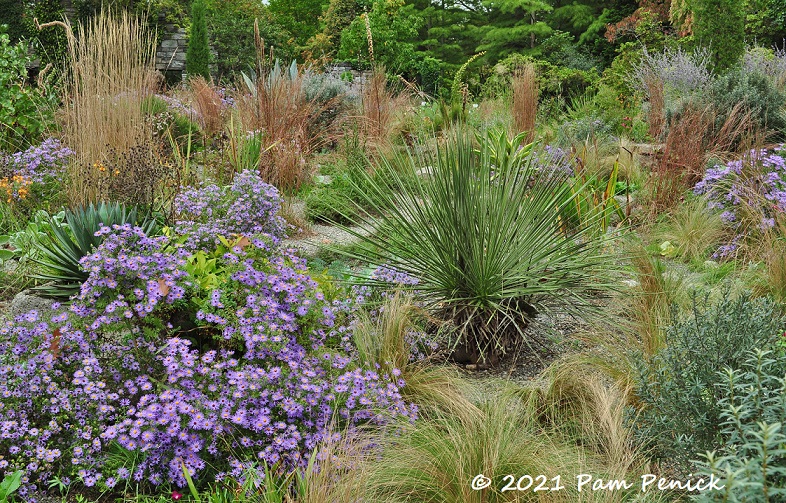
And what is this strappy plant — a dasylirion?
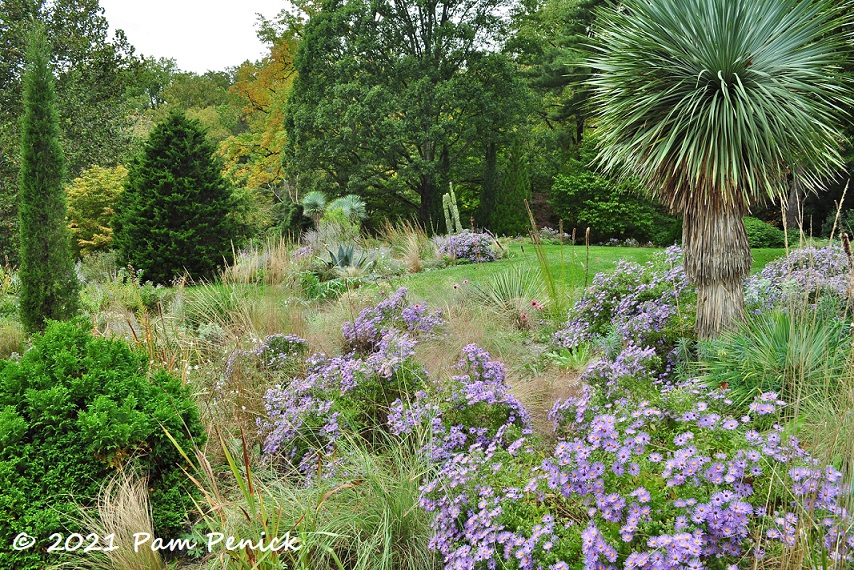
I wandered in this beautiful space, soaking it all in.
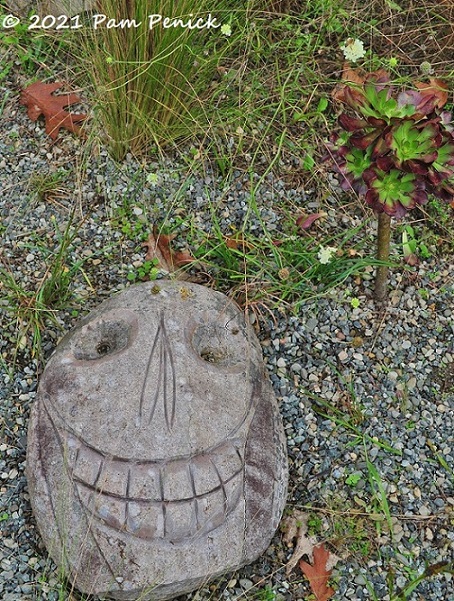
Someone else is looking pretty happy here too. I believe this is a Marcia Donahue stone carving.
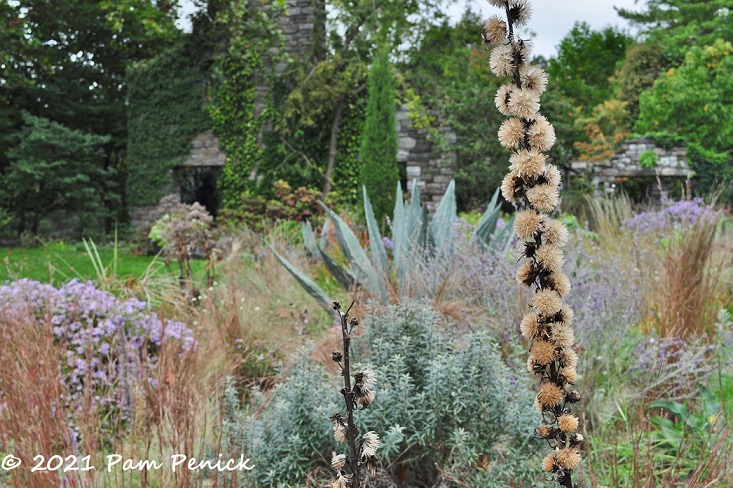
This garden makes me appreciate the silver-green and rusty-brown Texas color palette even more.
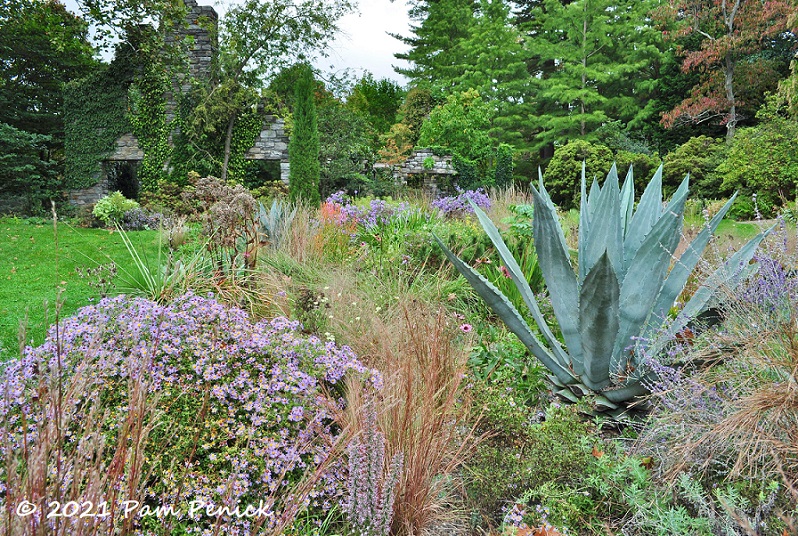
A few medium-sized American agaves add muscular form amid the wispy grasses and mounding asters.
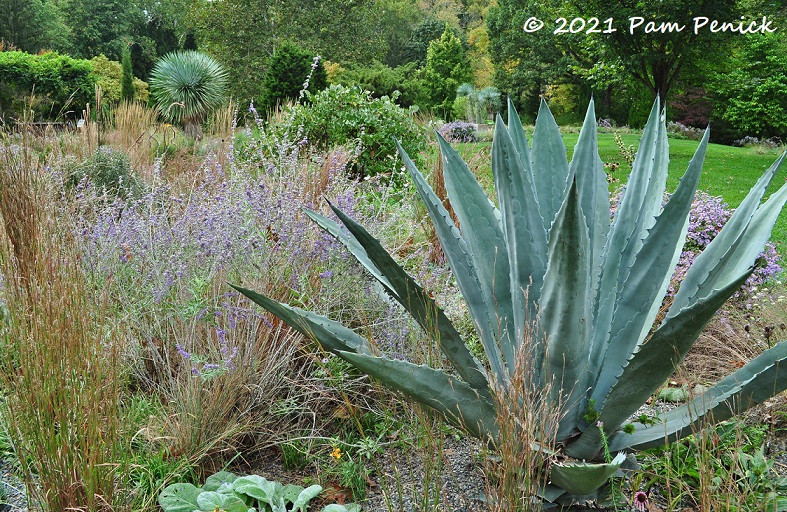
I assume these are dug up before winter and stashed in a greenhouse until spring.
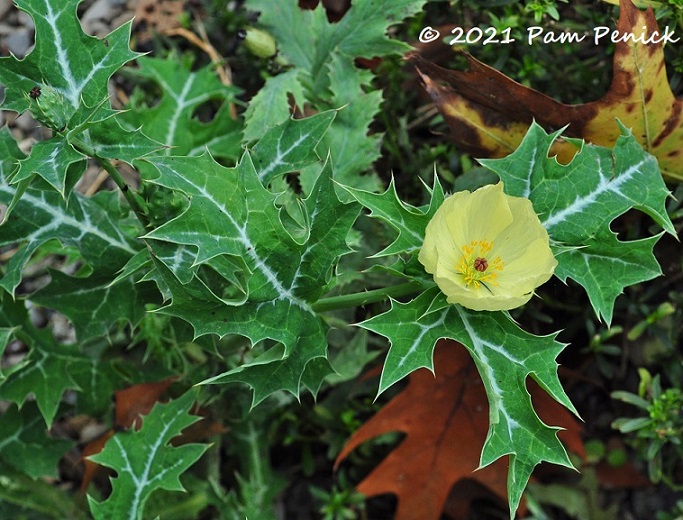
A pretty plant with holly-like leaves and mallow-like flower — some sort of mahonia? Update: It’s Argemone mexicana.
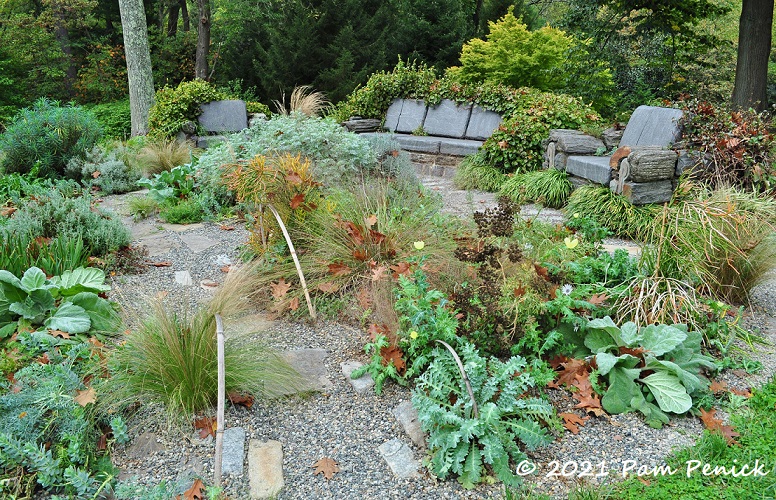
Just outside the ruin, an entire living room set of furniture made of stone is becoming one with the encroaching garden. This surprising and witty scene always makes me smile.
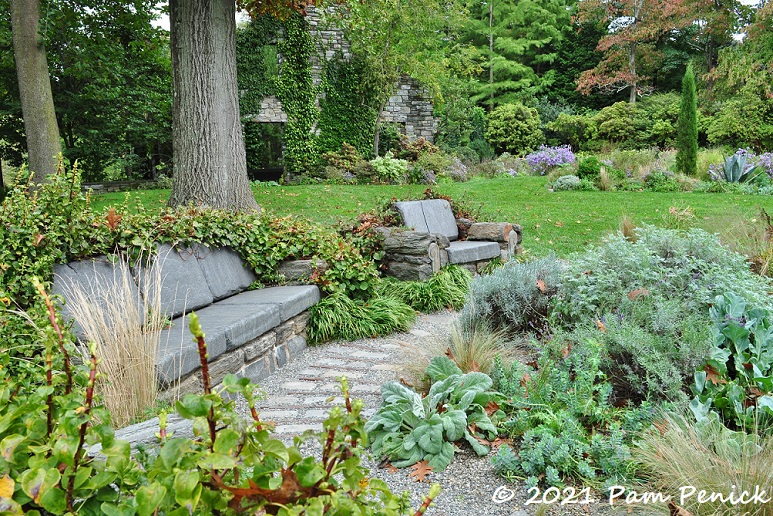
The stone cushions are actually pretty comfortable.
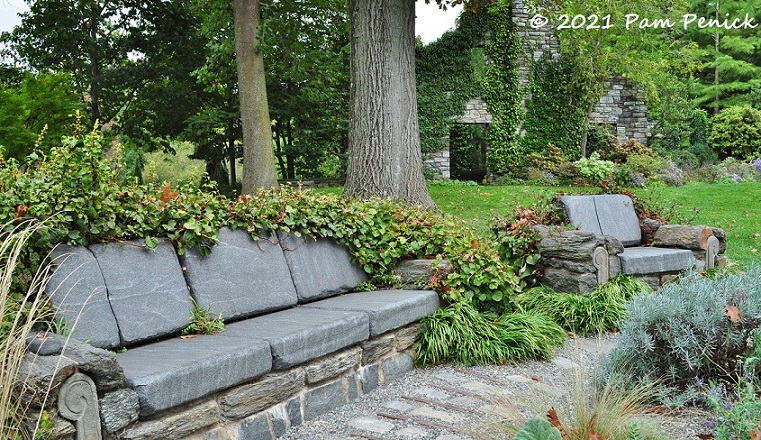
A stone TV remote even perches on the sofa arm!
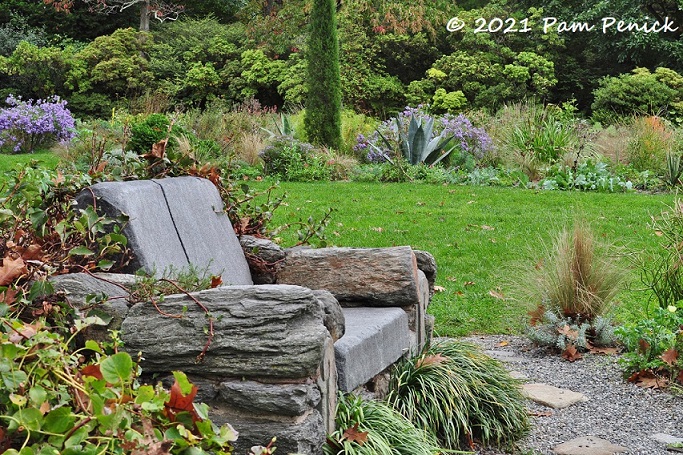
But who could dream of watching television when this view surrounds you?
Up next: The mystical, mournful Ruin garden at Chanticleer. For a look back at Paxson Hill Farm’s remarkable garden, Part 3, click here.
__________________________
Digging Deeper
Need design help with your yard? Hire me as your personal garden coach! Maybe you need replacement plant ideas after the big freeze. Or maybe your landscaping has grown tired, and you want fresh curb appeal. Or perhaps you’re ready to get rid of some lawn and create a pollinator garden, bird habitat, or hangout space for you and your friends. I’m here to help! Contact me to let me know what’s going on, and let’s figure it out together. My range is Austin and suburbs within a 25-min. drive of NW Austin, but I’m flexible and can travel farther with a surcharge, so let me know where you are. Weekday morning appts. only.
Come learn about gardening and design at Garden Spark! I organize in-person talks by inspiring designers, landscape architects, authors, and gardeners a few times a year in Austin. These are limited-attendance events that sell out quickly, so join the Garden Spark email list to be notified in advance; simply click this link and ask to be added. Season 8 kicks off in fall 2024. Stay tuned for more info!
All material © 2025 by Pam Penick for Digging. Unauthorized reproduction prohibited.


This is some rock garden. It is so lush. I wonder if they have to take in the Yucca rostrata or maybe tie them up in some sort of protection during winter.????
Hi, Linda. They don’t take in the Yucca rostrata and as far as I know, don’t protect them. I’ve had one for years, unprotected, in damp, cold-winter New Jersey– just about an hour northeast of Chanticleer.
Sorry I mis-typed your name, Lisa!
Yucca can be remarkably cold hardy. Thanks for the info, Steve.
thank you for this! The yellow-flowered thistly plant might be Argemone mexicana. I had to check Chanticleer’s USDA zone, which appears to be 7a — wow! And 60 inches of rainfall?! Really amazing skills to make a Texas-style gravel garden look at home in Pennsylvania.
I see Argemone mexicana is native from Texas to Pennsylvania and beyond. Thanks for the ID, Denise. And yes, wow about 60 inches of rain!
After visiting Austin for the first time just this past week (enjoyed it), I can see how Chanticleer’s gravel garden is reminiscent of your area. I love Chanticleer, too, and am lucky that it’s about an hour’s drive from me. By the way, we experienced some wild temperature swings in Austin las week. Oh, and Zilker Botanical Garden was a good destination, even in February– would love to see it in the spring and/or fall.
I am envious of your proximity to Chanticleer, Steve. Lucky you! And Austin is still experiencing wild temperature swings this week. It was 87 F today, and it’ll only reach 34 F tomorrow. Since you enjoy garden visiting, come back to Austin sometime in April/May or October/November. Those are our best garden-visiting times of year.
Oh this was just lovely! I am now struck by the fact I need a leaning Yucca rostrata, mine are all pretty darn straight in their growing habit. As for the deflated opuntia, yes! That’s what Opuntia humifusa (and several others) do to prepare themselves for cold weather. They’ll pop back up when it warms.
Thanks for focusing on the agaves there at the end. I’d been spying them here and there in your other photos and thought “why isn’t she mentioning them!”. With 60″ of rainfall as Denise noted, and being 7a there is no way they leave them out over the winter… unless they have amazing drainage and they cover them Ruth Bancroft style?
I have a Y. rostrata that’s leaning a little more than I’d like because it’s trying to get out from under a tree. So maybe park an umbrella on one side of yours — ha! How interesting about the deflated opuntias in colder, wetter climates. As for the agaves, you KNOW I couldn’t have skipped those. I’m especially impressed with their collection knowing they must dig them all up and store them somewhere warm and dry over the winter.
To someone in a climate where gravel is an effective way to cook your plants, gravel in cooler wetter climates appears to be effective compensation for insufficient heat, frequently cloudy days, and more generous moisture levels. A way to see plants that normally would not grow in that climate. Which is a nice thing. The equivalent here is lavish irrigation, which is a luxury.
I gawk at the greenness of the grass. The greenest grass here never looks as green as there.
The “something like mahonia” might be Argemone mexicana.
Great post! Thanks for the tour!
It’s interesting to hear the perception/reality of gravel gardens in your region (Southern CA), hb. I wonder if, in hot climates, the success of a gravel garden depends chiefly on the kind of plants one is trying to grow. Even in subtropical, torrid Austin, not to mention super-hot and dry Phoenix, gravel gardens can be quite successful. Rock Rose/Jenny’s former garden in Austin was a good example. She used flagstone and gravel mulch to shelter the roots of her plants from the Texas sun, and she often said rock protected them better than wood mulch. Of course she was growing heat-tolerant wildflowers and yuccas and the like — but also some roses and lusher plants. However I wouldn’t be surprised if she mulched the latter with organic mulch.
Lots of food for thought! So much depends on one’s high and low temps, rainfall and the time of year it comes, and humidity, especially the unrelenting summer humidity that denies Texas gardeners a lot of Mediterranean plants. I do love how Chanticleer has created such sharp drainage on their rocky hill so their dry-loving plants don’t rot in the cold, wet winter.
And yes, that green, green grass — a hallmark of eastern gardens. Thanks for the Argemone plant ID too!